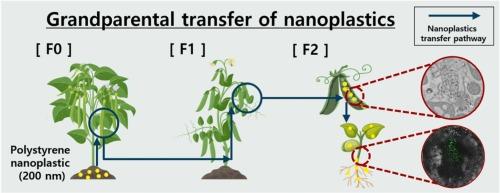豌豆植物(Pisum sativum)中纳米塑料的祖父母转移:从土壤到第三代的传递
IF 11.3
1区 环境科学与生态学
Q1 ENGINEERING, ENVIRONMENTAL
引用次数: 0
摘要
随着土壤环境中微纳米塑料丰度的增加,纳米塑料向土壤生物群迁移的问题日益受到关注。为此,本研究旨在通过长期暴露于纳米塑料(200nm,聚苯乙烯)来确定植物体内纳米塑料的多代转移。只有第一代(F0)豌豆植株暴露于纳米塑料,随后的几代(F1和F2)重新种植在没有纳米塑料的清洁土壤中。采用激光共聚焦扫描显微镜和透射电镜对F2代豌豆果实和植株进行了观察。与对照相比,观察到纳米塑料的绿色荧光。纳米塑料位于细胞内和细胞间隙,并被包裹在内质网和液泡内。在F2植株中检测到纳米塑料荧光,证实纳米塑料不仅可以遗传给子代,而且可以遗传给第三代。我们的研究结果表明,纳米塑料暴露于第一代可以持续传递给后代,并进一步强调它们可以在土壤生态系统中持续循环。它还表明纳米塑料可以通过食物到达人类,并呼吁改进针对微塑料和纳米塑料的食品安全措施。本文章由计算机程序翻译,如有差异,请以英文原文为准。

Grandparental transfer of nanoplastics in pea plants (Pisum sativum): Transmission from soil to third generations
With the increase in micro- and nanoplastic abundance in the soil environment, there has been growing concern regarding the translocation of nanoplastics to the soil biota. To this end, this study aimed to determine the multigenerational transfer of nanoplastics in plants by chronic exposure to nanoplastics (200 nm, polystyrene). Only the first generation (F0) of pea plants was exposed to nanoplastics, and subsequent generations (F1 and F2) were replanted in clean soil without nanoplastics. Pea fruits and plants of the F2 generation were examined using confocal laser scanning microscopy and transmission electron microscopy. Green fluorescence of the nanoplastics was observed in contrast to the control. Nanoplastics were located in intracellular as well as intercellular spaces and enclosed within the endoplasmic reticulum and vacuoles. Nanoplastic fluorescence detected in F2 plants confirmed that nanoplastics can be transferred not just to daughter but also to third generations. Our results suggest that nanoplastics exposed to the first generation can be continuously transferred to subsequent generations and further emphasize that they can be continuously circulated in soil ecosystems. It also shows that nanoplastics can reach humans through food and calls for improved food safety measures against micro- and nanoplastics.
求助全文
通过发布文献求助,成功后即可免费获取论文全文。
去求助
来源期刊

Journal of Hazardous Materials
工程技术-工程:环境
CiteScore
25.40
自引率
5.90%
发文量
3059
审稿时长
58 days
期刊介绍:
The Journal of Hazardous Materials serves as a global platform for promoting cutting-edge research in the field of Environmental Science and Engineering. Our publication features a wide range of articles, including full-length research papers, review articles, and perspectives, with the aim of enhancing our understanding of the dangers and risks associated with various materials concerning public health and the environment. It is important to note that the term "environmental contaminants" refers specifically to substances that pose hazardous effects through contamination, while excluding those that do not have such impacts on the environment or human health. Moreover, we emphasize the distinction between wastes and hazardous materials in order to provide further clarity on the scope of the journal. We have a keen interest in exploring specific compounds and microbial agents that have adverse effects on the environment.
 求助内容:
求助内容: 应助结果提醒方式:
应助结果提醒方式:


